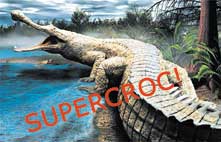|
|
 What a Croc! What a Croc!
by Mark Burns
If adults scold you this Thanksgiving for eating with your elbows on the table, politely suggest to them that at least you’re not doing to the turkey what SuperCroc did to the bird’s dinosaur ancestors. Though you might want to save some of the details for after dinner.
SuperCroc — whose scientific name is Sarcosuchus imperator, Latin for “flesh crocodile emperor” — stalked the rivers of Africa some 110 million years ago, devouring dinosaurs of all shapes and sizes. At 40 feet long (same as a bus) and 10 tons heavy with a six-foot-long head, it was at least twice as big as the biggest modern-day croc. A funky nasal cavity shaped like a small toilet bowl gave it a powerful sense of smell, plus, scientists think, a weird call.
If Croc Hunter Steve Irwin’s dream-come-true were alive today, your Thanksgiving turkey would be down its gullet in seconds. It could probably eat you in two bites. (If you’ve already hit your adolescent growth spurt it might take two and a half.)
 |
| SuperCroc meets paleontologist Paul Sereno (above), plus an artist’s drawing of what SuperCroc probably looked like alive (above right). |
Like modern crocs, these mega-predators would stay hidden in the murky water by the shoreline until prey came to drink. Then, in a fraction of a second, SuperCroc would snap its head around, crush the victim in its jaws and drag it into the water for the kill.
“As a croc hunter, this is what you think about at night,” says Paul Sereno, a paleontologist who found several tons of SuperCroc fossils on a recent expedition. “It makes your neck ache just thinking about it.”
Which is maybe why you shouldn’t try to ambush the turkey and drag it to the bathtub with your teeth.
Putting the Pieces Together
Sarcosuchus was discovered by French paleontologists back in 1966, but they only found a few pieces. To learn more, Sereno, a paleontologist with National Geographic, led an expedition to Africa last year. He picked a patch of Ténéré Desert in the middle of Niger, a landlocked country at the center of the Sahara. Though the desert is heaps of sand and rock now, it was lush with vegetation and wide rivers in prehistoric times — making it a treasure trove for today’s fossil hunters.
In four months, Sereno and his team of 16 sifted through 20,000 tons of fossils to find enough SuperCroc bones — about half of one crocodile — to build a life-size model. Parts of the tail and legs were missing, possibly, Sereno says, because crocs like to eat those parts off dead friends.
The bones tell paleontologists a lot about how the croc lived. Sereno learned it had good jaws for eating meat and a working brain the size of a walnut. SuperCroc was kind of dumb, but plenty smart enough to be a sly predator.
Can You Dig it?
When Sereno wasn’t laboring under the 130-degree desert sun he was examining modern crocs on their home turf, looking for inherited links between modern crocs and SuperCroc. This also taught Sereno about how SuperCroc may have behaved.
If you’re interested in hunting fossils, it helps to be a nature nut, Sereno says. When he was a kid, he was fascinated by collecting leaves and bugs. If you’re interested in paleontology, Sereno suggests you start by signing up for nature workshops at a local park. Doing school science projects on paleontology will give you a taste of what it’s like. Beyond that, you’ll need a lot of education and good grades.
To you future fossil hunters, here’s hoping you win that National Geographic research grant. Until then check out these:
- Learn more about Sereno’s adventure and the beast he dug up when National Geographic’s 2-hour documentary SuperCroc airs 8pm
December 9 on NBC.
- The SuperCroc website, www.supercroc.org, tells about Sereno’s expedition and what scientists know so far about the giant croc.
- When in DC, stop by Explorers Hall to see a plaster cast of the skeleton, the original skull, a bone collection and a life-size model of the mega-croc’s fleshed-out head (shows through January 2, 2002).
Kids’ Stuff
Friday, November 23
Biodiversity - Discover how the number and type of wildlife species have an effect on the ecosystem. Ages 8-12. 1-2:30pm @ North Tract, Patuxent Research Wildlife Refuge, Laurel. Free; rsvp: 301/497-5887.
 Saturday, November 24 Saturday, November 24
Birds for Kids - Join Ranger Brian to learn about some of the common birds we see in winter at birdfeeders and in the trees. Learn how to tell them apart, what they eat, and take home your own pine cone birdfeeder. 10am @ Kinder Farm Park, Millersville. Free; rsvp:
410/222-6115.
Sunday, November 25
Going Nuts - Look for seeds, nuts, fruits and pinecones just like the chipmunks and squirrels do during the winter. 1pm @ Kinder Farm Park, Millersville. Free; rsvp:
410/222-6115.
Tuesday, November 27
Silly Stories - Chuckle with the youngsters during the readings of Giraffes Can’t Dance and No Moon, No Milk. 10am @ Barnes & Noble, Annapolis Harbour Center. Free: 410/573-1115.
Thursday, November 29
Music for Babies - Stimulate infant development at Your Baby Needs Music, a special music-filled program of fingerplays, stories and movement. Led by award-winning educator Ann Rachel. Up to 24 months. 10:30am @ Crofton Branch Library. Free; rsvp: 410/222-7915. Also 7pm @ Severna Park Branch Library: 410/222-6270.
Copyright 2001
Bay Weekly
|